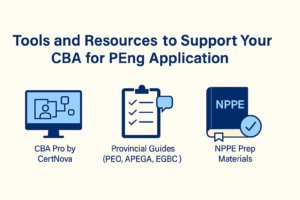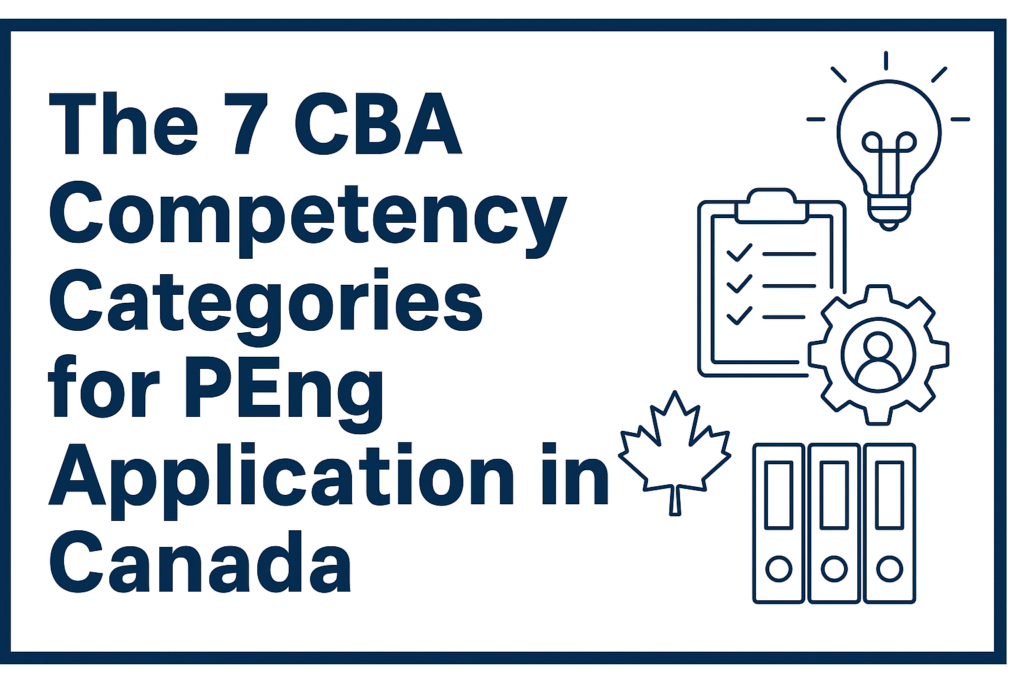Introduction
If you’re an engineering graduate or internationally trained professional aiming to earn your Professional Engineer (PEng) designation in Canada, you’ve likely encountered the term CBA—Competency-Based Assessment. It’s not just another form to fill out. It’s the cornerstone of how engineering regulators across Canada, like Professional Engineers Ontario (PEO) and APEGA, evaluate your readiness to practise as a licensed engineer. Understanding how to properly navigate the CBA for PEng application process is not only vital—it’s mandatory.
The CBA framework requires applicants to demonstrate their engineering experience through detailed work examples, categorized into seven distinct competency areas. These CBA competency categories Canada regulators define span everything from technical problem-solving to ethics, project management, and sustainability. Each category represents a pillar of professional engineering practice, and applicants must meet specific rating thresholds to move forward in their licensure journey.
In this blog post, we’ll break down these seven CBA competency categories to help you fully understand what assessors expect. Whether you’re starting to draft your experience records or just planning ahead, mastering these categories is key to submitting a strong and successful CBA for PEng application. Let’s dive into the details of each category—and how you can use them to showcase your qualifications with confidence.
What Is the CBA and Why It Matters for Your PEng Application?
The Competency-Based Assessment (CBA) is a standardized method used by engineering regulators across Canada to evaluate the work experience of PEng applicants. Unlike traditional employment history summaries, the CBA requires applicants to demonstrate specific competencies—real skills and behaviors—acquired through engineering work. The goal? To ensure that every applicant, regardless of where they gained their experience, meets the professional and ethical standards expected of a licensed engineer in Canada.
For those navigating the CBA for PEng application, this process is more than just an administrative hurdle. It’s a structured opportunity to reflect on your career, highlight your achievements, and demonstrate how you’ve applied engineering principles in diverse contexts. Each work example you provide must align with one or more of the CBA competency categories Canada regulators have defined. These categories are the backbone of your application and determine whether you’re ready for independent engineering practice.
Here’s why the CBA for PEng application matters so much:
-
It standardizes evaluation across provinces and international backgrounds.
-
It focuses on competence, not just job titles or time served.
-
It supports fairness, offering a consistent process for all applicants.
-
It aligns with public safety, ensuring engineers meet technical, ethical, and professional expectations.
Understanding the framework is your first step toward licensure success. Let’s now explore each of the seven CBA competency categories Canada regulators require.
Overview of the 7 CBA Competency Categories Canada Engineering Associations Require
The heart of your CBA for PEng application lies in how well you can demonstrate competence across the seven CBA competency categories Canada’s engineering regulators use. Each category reflects essential dimensions of engineering practice—technical proficiency, communication skills, leadership, ethical integrity, and societal awareness. Let’s explore what each category demands and how to approach them strategically.
1. Technical Competence
-
Design, analysis, safety codes, risk mitigation
-
Apply standards used in Canada or international equivalents
-
Prepare detailed specifications and technical solutions
2. Communication
-
Verbal and written clarity
-
Tailoring messages to technical and non-technical audiences
-
Presenting ideas, drafting reports, participating in meetings
3. Project and Financial Management
-
Budgeting, resource planning, scheduling
-
Risk and change management
-
Understanding the financial implications of engineering work
4. Team Effectiveness
-
Collaborating with professionals across disciplines
-
Respecting diverse roles
-
Conflict resolution and team leadership
5. Professional Accountability
-
Adhering to Codes of Ethics and regulations
-
Understanding liabilities, seals, and scope of practice
-
Demonstrating ethical judgment
6. Social, Economic, Environmental and Sustainability
-
Public safety and environmental impact
-
Incorporating sustainable solutions into designs
-
Recognizing regional and Indigenous practices
7. Personal Continuing Professional Development
-
Participating in learning activities
-
Identifying and addressing knowledge gaps
-
Developing a formal growth plan
Each of these plays a pivotal role in building a credible CBA for PEng application that meets licensing standards.
How to Structure Your CBA Work Examples Using the STAR Method
When writing your CBA for PEng application, it’s not enough to list your job duties. You must show assessors that you’ve applied engineering principles competently and ethically. That’s where the STAR method comes in:
S – Situation
Set the scene. Describe the project, your role, and the context.
T – Task
What was your specific responsibility or goal?
A – Action
What did you do? Highlight your engineering judgment, leadership, and compliance with standards.
R – Result
Share the outcome. Was the issue resolved? What impact did your work have?
Using STAR ensures each example in your CBA for PEng application is focused and measurable across all CBA competency categories Canada regulators require.
Common Pitfalls When Writing About CBA Competency Categories in Canada
Avoid these frequent errors:
-
Overuse of “we” instead of “I”
-
Generic examples reused across competencies
-
Weak validators who can’t verify your role
-
Neglecting professional standards competencies
-
Ignoring soft skills like communication and sustainability
Strong CBA for PEng application submissions address each competency clearly, with well-structured, validator-supported work examples.
Tools and Resources to Support Your CBA for PEng Application
Writing a strong CBA for PEng application doesn’t need to be overwhelming. Here’s what can help:
-
CBA Pro by CertNova: productivity to map experiences, draft examples, and get feedback
-
Provincial guides (PEO, APEGA, EGBC): Templates, webinars, and score expectations
-
NPPE Prep Materials: Helps reinforce ethics and accountability areas tied to your CBA

These tools align your content with the expectations of the CBA competency categories Canada engineers must meet.
Final Checklist for CBA Competency Categories in Canada
Before submitting your CBA for PEng application, confirm:
-
✅ All 7 categories are addressed
-
✅ Work examples use STAR format
-
✅ Validators are qualified
-
✅ Minimum score averages are met
-
✅ Professional standards competencies receive special focus
A complete, well-written submission ensures your success across all CBA competency categories Canada licensing boards evaluate.
Conclusion
Completing the CBA for PEng application is a defining step in your engineering career. It’s your opportunity to showcase not just what you’ve done—but how you’ve done it—with professionalism, ethics, and skill. By mastering the seven CBA competency categories Canada regulators require, you demonstrate that you’re ready to take full responsibility for engineering work and serve the public interest.
Whether you’re just beginning or refining your submission, remember: clarity, reflection, and structure matter. Use tools like CBA Pro, follow the STAR method, and don’t underestimate the power of strong examples. Your future as a licensed engineer starts with how well you tell your story.


